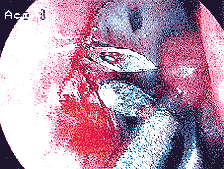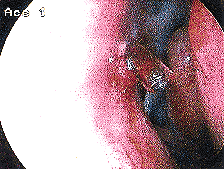Intranasal endoscopic technique offers advantages over external approach
Retrospective study finds both operative time and blood loss less with endoscopic technique.
ALBANY, N.Y. — Patients with epiphora secondary to canalicular stenosis can be effectively treated with the intranasal endoscopic technique for conjunctivodacryocystorhinostomy (CDCR) with Jones tube placement, according to a study that compared the newer technique to the traditional external approach with a medial canthal incision.
The study, which was presented at the American Academy of Ophthalmology meeting last year, found that operative time and blood loss were comparable in the two groups, although the endoscopic group was slightly lower for each of these two variables. In addition, the investigators did not find it necessary to use laser, radiofrequency or monopolar devices for intranasal hemostasis.
“The traditional or ‘open’ approach as described by Jones has been around for over 3 decades,” said co-author Dale R. Meyer, MD, director of ophthalmic plastic and reconstructive surgery at Lions Eye Institute at Albany Medical College here. “This involves an external incision and creation of an ‘internal connection’ with insertion of the Jones tube.”
Endoscopic approach
Endoscopic techniques, in contrast, were first applied to dacryocystorhinostomy (DCR) surgery beginning in the early 1990s as a way “to avoid the external skin incision and possibly shortening the surgery and minimizing blood loss,” Dr. Meyer said. However, “to some extent, there has been some controversy as to the benefit of the endoscopic approach to DCR because those benefits are somewhat mitigated by a lower success rate compared with the external DCR approach.”
Dr. Meyer and co-author Dr. William Trotter concentrated on the application of an endoscopic technique for CDCR with Jones tube placement. “This is something that has not been well described in the peer-reviewed literature,” Dr. Meyer said. Compared with simple nasolacrimal duct obstruction, canalicular stenosis “is a more difficult condition to treat and a much less common condition.” Consequently, “the need for CDCR with Jones tube is less frequent than the need for DCR.” Among the conditions associated with canalicular stenosis are trauma, systemic chemotherapy and herpes zoster infection.
The retrospective, nonrandomized comparative study reviewed 13 consecutive CDCR with Jones tube procedures that were performed at Albany Medical Center between 1992 and 1999. Three of the 10 patients had bilateral surgery. Five of the 13 procedures that took place mostly in the early study period were performed by means of a traditional external approach with a medial canthal incision. The other eight procedures were performed with an intranasal endoscopic approach and instrumentation with Jones tube placement under direct endoscopic visualization.
Outcomes favor endoscopic group
 ---Creation of nasal ostium with “back-biting” forceps. Needle marks planned tract from middle meatus to medial canthus.
---Creation of nasal ostium with “back-biting” forceps. Needle marks planned tract from middle meatus to medial canthus.
The main outcome measures were total operative time, estimated blood loss, intraoperative and postoperative complications, and need for secondary surgery. Average operative time was 59 minutes in the endoscopic group and 74 minutes in the external group. Average blood loss also was lower in the endoscopic group, 3.5 mL versus 4.4 mL. “For both groups, though, the blood loss was really quite minimal,” Dr. Meyer said.
All 13 cases were successfully completed. “There were no intraoperative complications,” Dr. Meyer said. However, postoperative adjustment of tube size or position was common. “That is typical for Jones tubes in general,” he said. In total, five of the eight endoscopic cases and three of the five external procedures required adjustment, which were performed as an office procedure with topical/local anesthesia. “Usually the variables that affect whether you need to change the tube size or position are intranasal,” Dr. Meyer said.
Two patients in the endoscopic group underwent secondary surgery for anatomic reasons. The first patient had a deviated nasal septum that was noted preoperatively. “The patient was offered primary surgery to address the deviated septum but declined,” Dr. Jones said. The second patient developed a granuloma in the medial canthal area of the right eye and a nasal adhesion on the left side of the nose. Ultimately, though, all cases in both groups demonstrated retained Jones tubes and relief of epiphora.
Pros and cons
 ---Jones tube in good position following endoscopic placement.
---Jones tube in good position following endoscopic placement.
Overall, the two authors believe endoscopic CDCR with Jones tube placement “is a useful technique,” Dr. Meyer said. “We feel it compares well with the traditional external method. However, each technique offers advantages and disadvantages to the surgeon.” For instance, an intranasal endoscopic approach requires additional instrumentation and there is a learning curve to use the new technology. Still, “today, most hospitals have this equipment available for otolaryngology work, where functional endoscopic sinus surgery is now mainstream,” Dr. Meyer said. Furthermore, the newer approach provides “excellent visualization, so you can readily see the placement of the tube within the nose. It is really a superb view.”
In conclusion, “The lacrimal surgeon can make good use of both methods, with proper patient selection and consideration of intraoperative needs and potential obstacles,” Dr. Meyer said. In the authors’ opinion, the strongest candidate for the endoscopic procedure is a patient who has had previous failed lacrimal surgery with canalicular stenosis.
For Your Information:
- Dale R. Meyer, MD, can be reached at Lions Eye Institute, 35 Hackett Blvd., Albany, NY 12208; (518) 262-2540; fax: (518) 262-2516; e-mail: meyerd@ mail.amc.edu.
